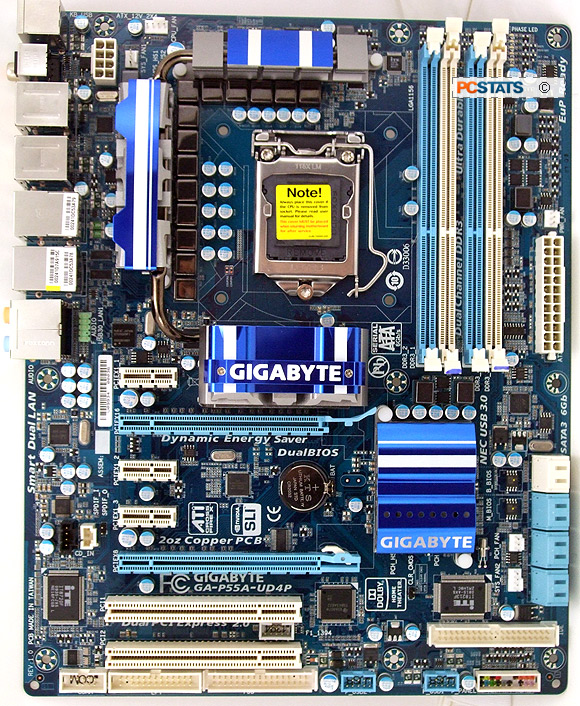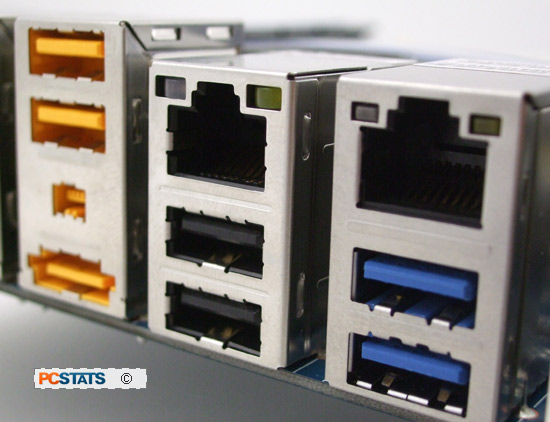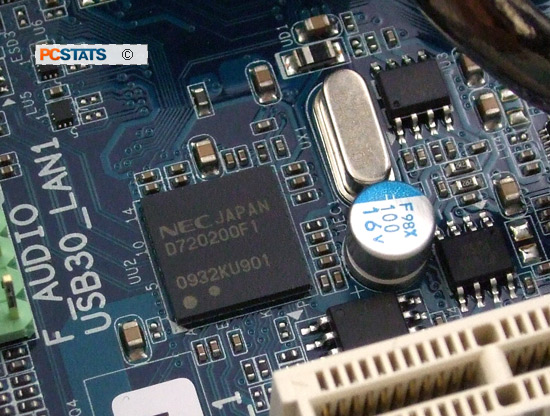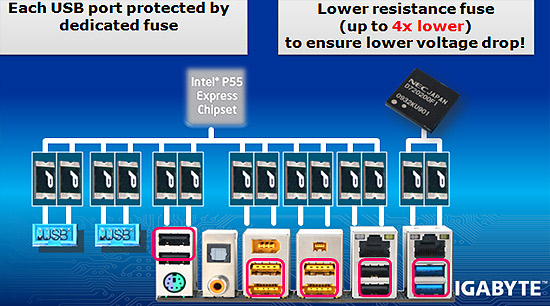While Intel's "Lynnfield" platform has barely had a chance to catch on in the
mainstream and enthusiast markets with its new 1156-pin socket design, a
CPU-powered PCI Express controller and a new lineup of processors, some
manufacturers have already decided to push out new features and revisions to
their existing "Lynnfield" motherboard families.
Enter the Gigabyte GA-P55A-UD4P motherboard, based
on Intel's P55 Express chipset with a trio of augmentations that push its
capabilities beyond the typical Intel P55 offering. Top of the list is
Gigabyte's 333 Onboard Acceleration marketing pitch, which in real world terms
is USB2.0 slots capable of outputting higher voltages to power external hard
drives and the like, a pair of 4800Mb/s SuperSpeed USB
3.0 ports for high-speed peripherals care of the brand new NEC PD720200
controller and 6.0 GB/s SATA III via Marvell's SE9128 controller for
faster hard drive transfers. The '333' moniker comes from
USB3.0, SATA III and 3x USB power. Phew... all the GA-P55A-UD4P needs now
is a Laser-7 optical connection and then you can finally hook up that
Wii!
As you might expect, these extra features Gigabyte has
included into the mix build up on the core features provided by the ubiquitous Intel P55
chipset. The GA-P55A-UD4P still has support for all of Intel's socket
1156 Core i5 700-series and Core i7 800-series processors, can
be installed with up to 16GB of DDR3 memory at speeds of 800/1066/1333/2200 in four
DDR3 memory slots. The board supports dual-videocard SLI/Crossfire gaming configurations
in a x8/x8 PCI Express 2.0 arrangement, or a single videocard in x16 mode.
Gigabyte's GA-P55A-UD4P motherboard also features
the companies Ultra Durable 3 technologies; meaning thicker 2oz copper PCB and
solid-state capacitors, as well as a 12-phase VRM power design and its Smart 6
suite of motherboard utilities. Although it has some cutting-edge features, the
GA-P55A-UD4P retails for a reasonable $210 CDN
($190 USD, £125 GBP).
It's quite affordable compared to similarly equipped motherboards.
 |
|
Gigabyte GA-P55A-UD4P
Motherboard |
|

 |
|
|
|
INCLUDES:
User's Manual, Driver CD, (4) SATA cables, I/O Shield, IDE cable,
SLI bridge |
N/A
|
|
Chipsets: Intel P55
Express
CPU Support: Intel Socket
1156
Memory Type: Dual Channel
DDR3
Videocard Support: (1) PCI Express
x16 2.0
Integrated Graphics:
No | |
| |
Storage options on this board are pretty expansive, but
most importantly the GA-P55A-UD4P is equipped with a little controller chip
tucked away by the memory slots called the Marvell SE9128. The Marvell
SE9128 is significant because it is the first controller to bring two
6GB/s SATA III ports
(RAID 0, 1) for use with compliant SATA III hard drives like the Seagate Barracuda
XT into the fold. While mechanical SATA III hard drives see a small boost in
performance, the real benefits are seen when using the latest generation
SSD or a pair of Barracuda XT's in RAID 0.
In addition the Intel PCH offers up six 3Gb/s SATA II connections (RAID
0, 1, 5, 10) and a JMicron JMB362 controller adds on two 3GB/s eSATA
II ports (RAID 0, 1, JBOD) at the rear I/O. In total, Gigabyte's
GA-P55A-UD4P motherboard may support up to eight SATA II and two SATA III
devices. A legacy IDE connector rounds out the board's supports older optical
drives.
 Around back at the
motherboard's I/O panel we find an extensive collection of ports, both old and
new. In blue are the two 4.8Gb/s USB3.0 jacks
,
these are paired off with two USB/eSATA combo ports that are intended
to function with external hard drives or peripherals such as the somewhat
rare hybrid eSATA thumb drive - USB supplies the power and eSATA the
data connection. In total there are eight standard USB 2.0 ports ( four
additional via header), two Firewire jacks (one extra via header), two Gigabit
LAN ports (with support for Teaming/Dual LAN connections), coaxial and optical
S/PDIF audio connectors for the 8-channel audio system, and multi-channel output
via six stereo jacks. There's also a legacy PS/2 port if you have an old mouse
or keyboard.
Around back at the
motherboard's I/O panel we find an extensive collection of ports, both old and
new. In blue are the two 4.8Gb/s USB3.0 jacks
,
these are paired off with two USB/eSATA combo ports that are intended
to function with external hard drives or peripherals such as the somewhat
rare hybrid eSATA thumb drive - USB supplies the power and eSATA the
data connection. In total there are eight standard USB 2.0 ports ( four
additional via header), two Firewire jacks (one extra via header), two Gigabit
LAN ports (with support for Teaming/Dual LAN connections), coaxial and optical
S/PDIF audio connectors for the 8-channel audio system, and multi-channel output
via six stereo jacks. There's also a legacy PS/2 port if you have an old mouse
or keyboard.
Gigabyte 333 'Onboard Acceleration'
With the GA-P55A-UD4P motherboard, Gigabyte is promoting its '333' motherboard enhancements,
these include USB2.0/3.0 slots capable of outputting higher voltages to power external
hard drives, 4.8Gb/s USB 3.0 ports for high-speed peripherals care of the
brand new NEC PD720200 controller and 6GB/s SATA III connections via Marvell's SE9128 for quicker
hard drive transfers.
The '333' name comes from USB3.0, SATA 3 and
3x USB Power.
The most interesting addition to Gigabyte's
GA-P55A-UD4P motherboard has to be SuperSpeed
USB3, via NEC's PD720200F1
controller. USB3.0 is
the third major revision of the Universal Serial Bus standard
that runs everything from your mouse and keyboard to flash drives to wifi adapters.
It brings with it a couple benefits along with the significant speed
jump, such as Sync-n-go (USB devices are instantly available), backwards compatibility, bidirectional
dual simplex data transfer protocol and better power efficiency (lower active/idle power states,
no device polling).
|

USB
3.0 ports are identifiable by the blue colour and nine electrical
connector pins. These ports are physically compatible with USB 2.0
and USB 1.1 devices and standard USB A-type cables. Only USB3.0 devices operate
at 4.8Gb/s however, USB2.0 devices will default to 480Mb/s.
|
While USB
2.0's 480Mb/s maximum bandwidth was enough for smaller flash-memory based devices (like
thumb drives or SD cards) USB 3.0 expands the bandwidth to a whopping 4.8Gb/s
(4800Mb/s), much more appropriate for larger mass storage devices. Much of this speed
improvement is due to USB 3.0 being a bi-directional bus, meaning it can
transfer information to a device and to a host computer simultaneously.
|

USB 3.0 operates with a bidirectional data transfer architecture; meaning you can
concurrently upload and download data at the same moment.
|
USB 3.0 is backwards compatible
with legacy devices, so you shouldn't have any problem plugging in USB 2.0
or USB 1.1/1.0 items into the GA-P55A-UD4P board's fancy new ports.
|

NEC's PD720200F1 controller is
responsible for two 4.8Gb/s USB 3.0 ports on the Gigabyte GA-P55A-UD4P motherboard. USB3.0 sockets are backwards compatible
with USB2.0 devices. |
Next up is a major boost to the electrical capabilities
of all the GA-P55A-UD4P's USB ports - Gigabyte are calling this
USB3x Power Boost. USB 2.0 and USB 3.0 ports natively supply
electricity to power external peripherals, but if too many devices or power
intensive devices are attached this can cause the USB bus to shut
down. Standard USB 2.0 ports are limited to 500mA maximum load, and the USB 3.0 specification increases this to 900mA. On the Gigabyte GA-P55A-UD4P motherboard
both of these values are increased, so more devices or things
like external hard drives can be powered by the USB ports alone.
USB2.0 power levels increase from 500mA
to 1500mA, and USB 3.0 power levels are bumped up from 900mA to
a maximum 2700mA. This isn't going to change the performance of any USB
device, but it will stop some especially power hungry things like external 2.5 inch
hard drive enclosures from conking out unexpectedly and increase overall system
stability if you use a lot of USB devices (and who doesn't?).
|

Each USB port is
protected by a solid-state fuse, that according to Gigabyte is also 4X
more power efficient.
|
In addition to boosting available power
over USB sockets, Gigabyte has improved the fusing behind them in case something goes
awry. Apparently the fuses on a motherboard reduce available power from the nominal 5V by
a small amount, typically to 4.6V. Solid state fuses like the ones pictures above
are standard to all recent motherboards, and you'll find them near
buy all USB ports/headers and Firewire devices if you care to look.
Gigabyte hasn't reinvented the wheel
here, it's just directed its electronic parts buyers to pick higher tolerance fuses
so power drop is reduced by a small amount (4.8V we are told, rather
than 4.6V for the standard fuse of this type). USB voltage levels can impact
device stability, and the number of devices connected to each port. Granted this is
a rather obtuse feature to discuss, but it does go to
show you that Gigabyte are indeed investing into the build quality of their boards.
The final trick in the 'Gigabyte 333' stables comes
in the form of 6Gb/s SATA III via the fabled Marvell SE9128 controller.

